We’ll talk about all those cute doggies who just love to jump up on people, discussing the reasons and solutions from a few trainers. Then, we’ll try applying things like logic and common sense to see where else we might go.
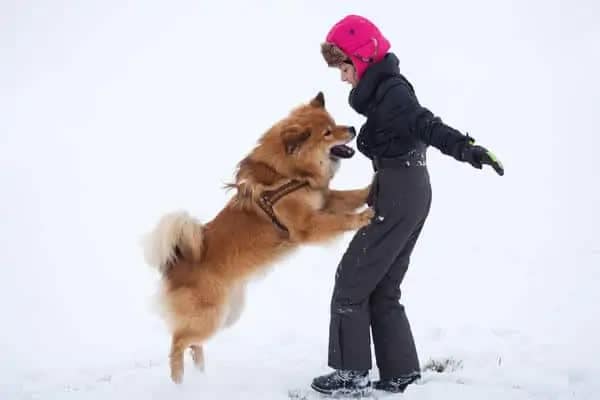
The old approaches
These methods include punishment and forceful restraint, such as a knee in the dog’s stomach, or a leash that you step on to break the dog’s jump. Looking around, one can still find a few references to such methods.
Here’s one from the Hartz Learning Center, which includes knee blocking or even an open-mouthed snarl. Or turning your back or leaving the room from The SprucePets.
These days, many others will call those the old ways, and instead give you the real science. Or, what they’ve been told is real…
From a local trainer
Eyes away, hands away, turn away is the method I used to teach dog owners how to stop their dogs from jumping on people. Basically, what we’re doing is taking social feedback away from the dog.
Good Buddy Dog Training
This is getting a little bit better, but I see two problems. One is that the dog is not given anything else to do. Another thought brings back memories from a few decades ago, when I tried turning my back on a Leonberger. This guy was not about to take no for an answer, throwing his front legs around my waist and just turning me back around.

When your dog does something you don’t like, there are 3 possible ways to respond. One is to punish him, another is to ask him not to do this and offer something acceptable as a replacement, and the last is to simply ignore it. When ignored, most dogs (and kids) will rapidly escalate to try and get your attention, and you are simply leaving it to the dog to try and guess what the heck it is that you want them to do.
Why not at least give him a hint here? Considering that the greatest issue in dog training may be a failure to communicate, why would you want to hide things and have guessing games?
Next, an Expert Trainer
In general animals perform behaviors because the behaviors have been rewarded. So to decrease the undesirable behavior we have to remove the rewards for undesirable behavior and instead reward alternate desirable behaviors. For instance, if a dog jumps on you, avoid moving or giving attention at all, instead, preemptively reward him for sitting repeatedly so that sitting becomes a habit.
Dr. Sophia Yin
Something that only rarely works, for reasons discussed in the very next section.
What is the dog coming for?
If you don’t first identify the problem, then any solution is no more than a guess.
While this could be to change the channel on the TV, he’s rather more likely coming for your attention. And that’s typically divided between reassurance-affection, and play. Once you determine which of these is the case, start thinking of how you can meet this need in a mutually acceptable manner. Next, start controlling the dog’s approach, guiding them into the way you’d like them to ask for this response.
So the nervous dog may run over to me, sitting or laying down. Maybe calmly leaning against me, looking up, and waiting patiently. I’ll then lean over or kneel down and give them a minute’s attention. After that, I’ll signal for them to follow me, and have them walk somewhere, with directed activity to focus the dog’s attention.
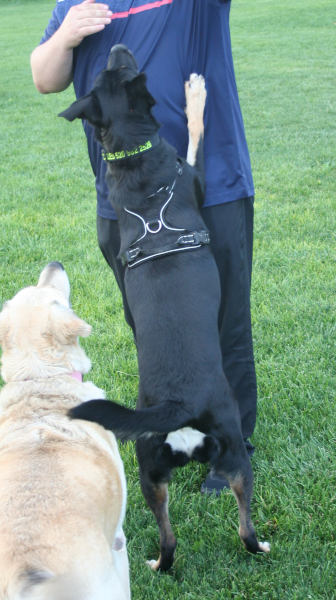
If it’s play, I may throw in some keywords the dog will recognize as to the type of play. If they get more excited, they will need to calm down and wait quietly (briefly), with the play as their reward. Of course, play may also have a reassurance component, so add a quiet moment of affection at the end.
In a few cases, the jumping itself has already become part of the game, and that’s handled a bit differently, in the stubborn dog.
In both cases, you will need some time and repetitions to teach the dog how to gently ask, then quietly wait, before they will get what they need. But simply ignoring it and telling them to just sit is something which works much better with a radio that you’re turning off, which will then gleefully just sit there.
And, sometimes they do have a good reason for jumping! Like housemates Rex and Roxy here, putting on a show at the dog park.
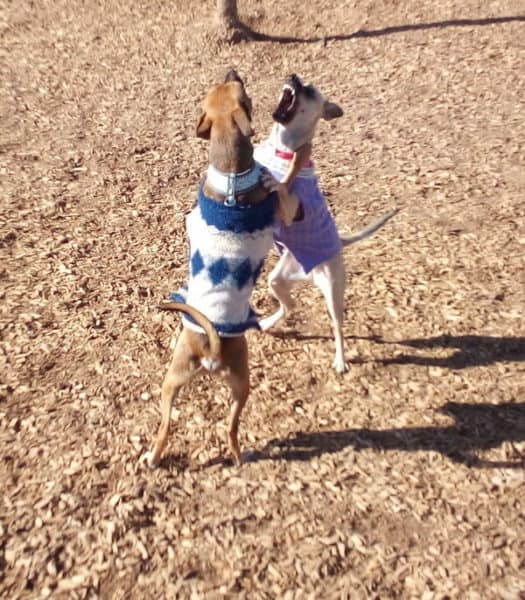
Start with their Attention
Before very long, you pretty much know if your dog’s about to jump up on you. Instead of dodging or restraining, just use a stop hand. You completely stop moving, and hold out a calm hand in front, between you and the dog. The hand should partly obscure the dog’s view, and block their progress. If they try to move around it, just slowly move the hand to follow, and remain still and silent. No matter what the dog does, do not start speaking or moving around any more than is needed.
You are refusing to give the dog the interactive attention he wants. But also making an honest effort to calmly tell him not to jump on you. A few dogs will just go away, and try again later. Most, however, will eventually pause, and just stop moving. At this point, you now have their undivided attention, to prompt a different behavior. Which one to use depends on why they came over. In some cases I just kneel down and gently pet the dog for a few minutes, and he then walks away.
They are coming over too often
Once some very scared dogs become familiar with a new person, many of them will not want to leave their presence. This may vary from sitting at my feet, to insisting on jumping into my lap. So here we focus on getting the dog familiar with the house and other activities, including brief periods being alone (with a toy or chew stick).
When I first bring in a very scared dog who seeks reassurance from people, I expect many won’t want to leave my side. So I establish a safe spot for the dog. This could vary from a crate, to a dog bed placed under a table and in the corner of the living room. Where the dog can easily see not only me, but everything that’s happening. I sit with her there for a moment, then slowly move away, while staying in her sight. The majority end up just laying in the corner of the room.
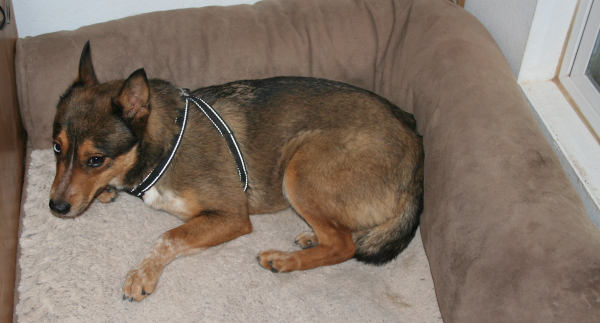
For those who still insist on staying near me, and especially those who jump up, we try several variations of how to stay near and hold my attention, without getting in the way. If working in the kitchen, I motion the dog to sit or lay nearby. When sitting on the sofa, I actively invite the dog to lay down next to me. The idea being, I don’t want the dog laying behind me while I’m working, or in my lap on the sofa. And, I periodically stop briefly, and give the dog some direct attention. This may start from several times each minute, slowly moving to every ten minutes or longer. Until you can build confidence and reduce the drive to be right next to you, you can at least partially control it.
Nervous from Excitement
There are some dogs who are just fine anywhere, provided all is calm and quiet. I’ve had several female dogs, under a year old, who would also pee from excitement. With the front landing tile, I just mop it up when I come in the house. Alternately, I’ll leave out a pee pad. While you can often increase the threshold for when this happens, it may not completely stop until they are over a year old.
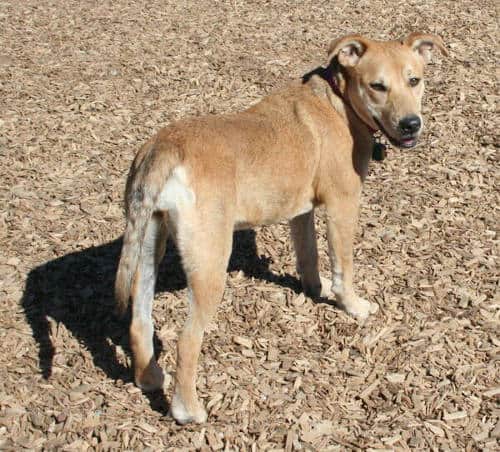
Others are mostly calm, but seem to loose all impulse control when something exciting happens. This could vary from starting to play, to meeting a person or dog they really like, or if they become just a little nervous. Gypsy was over a year old before she could control that.
Every time I came in the door, Zia would jump up in excitement. I noticed that she often stayed up on two legs, so I taught her to instead just dance a bit. I never mentioned that to her foster, and waited until they found out for themselves.
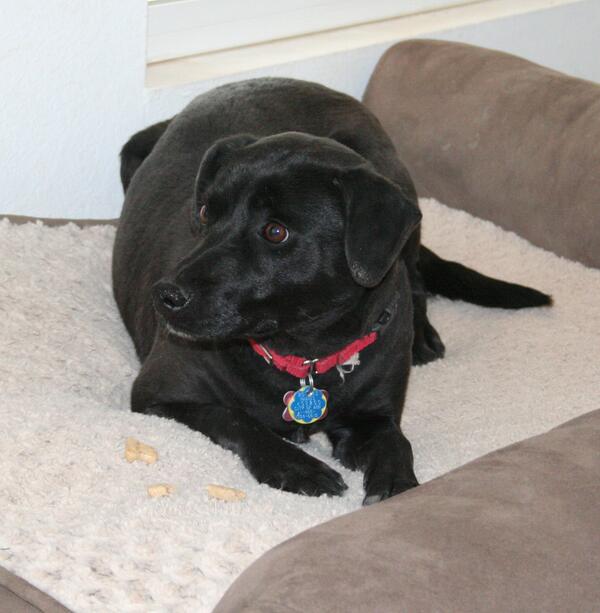
Habituated Behavior
Once a dog acquires social skills and feels confident, the jumping on people will often stop. However, a very few of them will find the play and surprise component attractive enough that the jumping becomes a habit. At this point the dog knows you don’t like it, but he does like it and can get away with it. The best approach is often to start the basic training that you skipped, to have the dog sit (extended), stay, wait, come, etc. on command. Then catch him before (or even after) he jumps up, and have him just sit there quietly for two minutes. If this was pure habit, he will very soon lose all interest in jumping. If not, then there was some other component also involved, and you need to supply some reassurance, affection, or acceptable play.
And, yes, this is a use of something called operant punishment. I’ve seen people try to do this instead with something called positive reinforcement, but that often ends up with the dog jumping or threatening to jump on the person, to prompt them to give him a reward. A situation where the dog is now in control.
On a larger note, it is often difficult to work with a dog having many habituated behaviors that are issues. In most cases, these behaviors are unintentionally reinforced by the owners, and nothing can be done with the dog until and unless the owners change. In some cases, this is just not possible and the best you can do is to try and manage the bad behavior.
Games, Rides, and the World
As they learn more games, with you and with other dogs, go for rides to different places, and start seeing the world, they will gather more confidence and social skills. The more they learn, the less they will feel the need to jump up on people.
